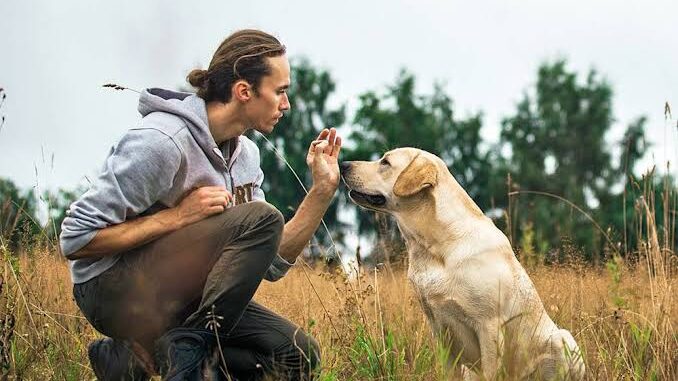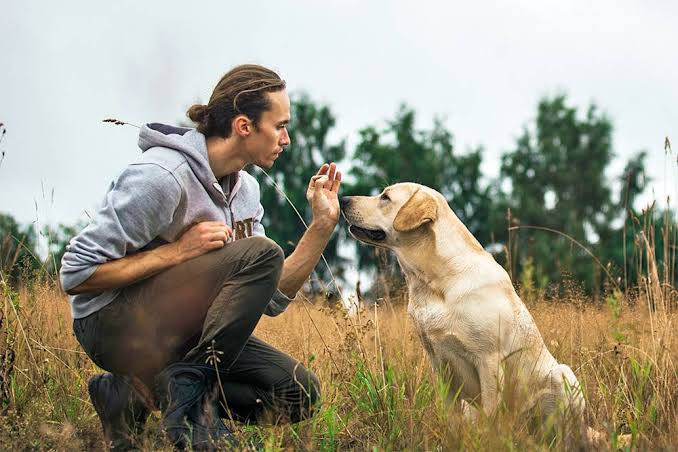
Dog Training Myths You Should Ignore: Training a dog should be an enjoyable, rewarding process rooted in understanding, patience, and evidence-based techniques. But unfortunately, there are many outdated and misleading ideas about dog training that persist even among well-meaning dog owners. These myths can hinder your dog’s progress, damage your bond, or even create behavioral issues over time.

In this guide, we’ll debunk five of the most common dog training myths and explain what modern, science-backed training really looks like.
5 Dog Training Myths You Should Ignore
Myth 1: You Need to Be the “Alpha” or Pack Leader
The Myth:
You must dominate your dog to earn respect and obedience. This includes tactics like eating before your dog, walking through doorways first, or even using physical punishment to “establish dominance.”
Why It’s Wrong:
This myth stems from outdated research on captive wolves, where scientists observed dominance hierarchies in artificial settings. These studies were misapplied to dogs, despite dogs being a distinct species with different social structures.
Modern science tells us:
- Dogs are not trying to “dominate” humans.
- Canine behavior is influenced by environment, learning, and communication—not hierarchical battles.
- Forceful, dominance-based techniques can cause fear, anxiety, and aggression.
The Better Way:
Focus on positive reinforcement and trust-building. Teach your dog desired behaviors by rewarding them—not by asserting control. Leadership is about consistency, clear communication, and mutual respect—not fear.
Myth 2: You Should Punish Bad Behavior to Stop It
The Myth:
When your dog does something wrong—like barking, chewing, or pulling—you should punish them immediately to teach them a lesson.
Why It’s Wrong:
Punishment might suppress behavior temporarily, but it doesn’t teach the dog what to do instead. Worse, it can cause emotional harm.
Punishment can:
- Increase anxiety or aggression
- Damage your bond with your dog
- Lead to confusion and fear-based behavior
Also, unless punishment is timed perfectly (within seconds), your dog won’t associate it with the unwanted action—they’ll just feel scared or confused.
The Better Way:
- Redirect: Guide your dog to a more appropriate behavior.
- Reward alternatives: If your dog barks at the door, teach and reward a “quiet” command.
- Manage the environment: Remove temptations and provide mental stimulation to prevent misbehavior.
Think about what you want your dog to do, not just what you want them to stop doing.
Myth 3: Some Breeds Can’t Be Trained
The Myth:
Certain breeds—like Huskies, Beagles, or Chihuahuas—are just too stubborn, dumb, or independent to train effectively.
Why It’s Wrong:
All breeds are trainable. What varies is motivation, attention span, and learning style. Some dogs are more food-driven, others are toy- or praise-driven. Some breeds are high-energy and need shorter, more engaging sessions.
Labeling a dog as “untrainable” often reflects a mismatch in training methods, not the dog’s ability.
The Better Way:
Tailor your approach to the individual dog:
- Use rewards that your dog values (food, toys, affection)
- Keep sessions short and consistent
- Understand your dog’s breed tendencies (e.g., scent hounds follow their noses, so train with high-value rewards and patience)
With the right motivation and method, every dog can learn.
Myth 4: You Shouldn’t Use Treats Because Dogs Will Become Dependent
The Myth:
If you train with treats, your dog will only behave when you have food. To ensure lasting obedience, you need to rely on discipline instead.
Why It’s Wrong:
This myth confuses bribery with reinforcement. A bribe is shown before a behavior to lure the dog; a reward comes after the behavior to reinforce it.
Used properly, treats:
- Speed up learning
- Help reinforce new behaviors
- Build positive associations
Dogs don’t get addicted to treats any more than people get addicted to praise or paychecks—they’re just motivated by what works.
The Better Way:
- Use treats heavily in the early stages of training.
- Gradually fade them out by switching to variable rewards (sometimes treats, sometimes praise).
- Reinforce behavior with other rewards your dog values—playtime, walks, or affection.
Properly reinforced behaviors become habits, not treat-dependent tricks.
READ ALSO: Dog-Friendly Vacation Spots: Where to Go with Your Pup
Myth 5: Dogs Know When They’ve Done Something Wrong (So Scolding Helps)
The Myth:
When a dog looks guilty, it means they know they misbehaved. So scolding or shaming them helps them learn not to do it again.
Why It’s Wrong:
That “guilty” look? It’s not guilt. It’s appeasement—a dog’s response to your angry tone or body language. They’re trying to avoid conflict, not confess.
Dogs live in the moment. Unless they’re caught during the behavior, they won’t connect your reaction to what they did 5 or 10 minutes ago.
The Better Way:
- Address unwanted behavior in the moment.
- Prevent repeat offenses by managing the environment (e.g., putting away shoes if your dog chews them).
- Reinforce desired alternatives.
Scolding after the fact teaches nothing. Observing, redirecting, and reinforcing are the keys to success.
FAQs
If I don’t punish my dog, how will they know what not to do?
Dogs learn best by understanding what you want them to do instead. Instead of punishment, use:
- Prevention (don’t leave food on the counter if your dog steals)
- Redirection (offer a toy when they chew something wrong)
- Positive reinforcement (reward calm, polite behavior)
How long does it take to train a dog using positive methods?
It depends on the dog’s age, temperament, and history. Some behaviors take days, others weeks. The good news is that positive training builds lasting habits and a better relationship—worth the investment of time.
Isn’t being the “alpha” just being a strong leader?
Not exactly. Good leadership in dog training doesn’t rely on fear or dominance. It’s about:
- Setting clear boundaries
- Being consistent
- Using positive motivation
Dogs thrive with kind, trustworthy guidance—not control.
What should I do if treats stop working?
Check a few things:
- Are you using high enough value treats?
- Is your dog full or distracted?
- Are you asking for too much too soon?
Sometimes switching to better rewards (like cheese, chicken, or liver treats) or adjusting the environment (fewer distractions) helps get your dog back on track.
Is it ever okay to say “no” to a dog?
Yes—but it should be informative, not punitive. Saying “no” without showing the dog what to do instead is confusing. Instead, follow up with guidance:
- “No”—then redirect to “sit” or “leave it”
- “Uh-uh”—followed by a rewardable action
Always teach the “yes” to balance out the “no.”
My dog listens at home but ignores me outside. Why?
Distractions change everything. Dogs need help generalizing behavior across contexts. Practice commands in multiple settings:
- Indoors
- Backyard
- Quiet park
- Busy street
Gradually increase difficulty, just like levels in a game.
Leave a Reply
You must be logged in to post a comment.